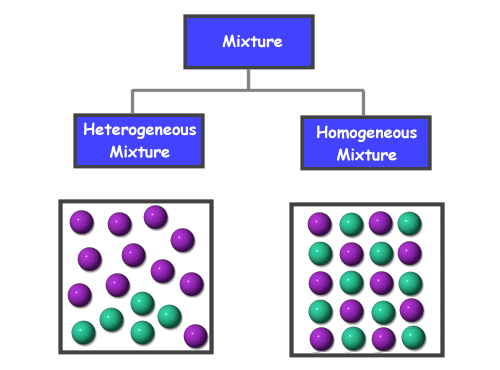Chemical Mixtures
One of the main aspects of chemistry is combining different substances. Sometimes combining substances can cause a chemical reaction and bonding which creates an entirely new substance called a compound. However, sometimes there is no chemical reaction or bonding. In this case, a mixture is formed from the combined substances. Mixture
A mixture is made when two or more substances are combined, but they are not combined chemically.
General properties of a mixture:
- The components of a mixture can be easily separated
- The components each keep their original properties
- The proportion of the components is variable
There are two main categories of mixtures: homogeneous mixtures and heterogeneous mixtures. In a homogenous mixture all the substances are evenly distributed throughout the mixture (salt water, air, blood). In a heterogeneous mixture the substances are not evenly distributed (chocolate chip cookies, pizza, rocks)

Solutions (homogeneous)
A solution is a mixture where one of the substances dissolves in the other. The substance that dissolves is called the solute. The substance that does not dissolve is called the solvent.
An example of a solution is salt water. These components can be easily separated through evaporation and they each retain their original properties. However, the salt is dissolved into the water to where you can't see it and it is evenly distributed in the water. In this example the water is the solvent and the salt is the solute.
What is the difference between a solution and a mixture?
In chemistry a solution is actually a type of mixture. A solution is a mixture that is the same or uniform throughout. Think of the example of salt water. This is also called a "homogenous mixture." A mixture that is not a solution is not uniform throughout. Think of the example of sand in water. This is also called a "heterogeneous mixture."
Alloys (homogeneous)
An alloy is a mixture of elements that has the characteristic of a metal. At least one of the elements mixed is a metal. One example of an alloy is steel which is made from a mixture of iron and carbon.
Suspensions (heterogeneous)
A suspension is a mixture between a liquid and particles of a solid. In this case the particles do not dissolve. The particles and the liquid are mixed up so that the particles are dispersed throughout the liquid. They are "suspended" in the liquid. A key characteristic of a suspension is that the solid particles will settle and separate over time if left alone.
An example of a suspension is a mixture of water and sand. When mixed up, the sand will disperse throughout the water. If left alone, the sand will settle to the bottom.
Colloids (heterogeneous)
A colloid is a mixture where very small particles of one substance are evenly distributed throughout another substance. They appear very similar to solutions, but the particles are suspended in the solution rather than fully dissolved. The difference between a colloid and a suspension is that the particles will not settle to the bottom over a period of time, they will stay suspended or float.
An example of a colloid is milk. Milk is a mixture of liquid butterfat globules dispersed and suspended in water.
Colloids are generally considered heterogeneous mixtures, but have some qualities of homogeneous mixtures as well.
Interesting Facts about Mixtures
- Smoke is a mixture of particles that are suspended in the air.
- Tap water is a mixture of water and other particles. Pure water or H2O is generally referred to as distilled water.
- Many of the substances we come into contact with every day are mixtures including the air we breathe which is a mixture of gases like oxygen and nitrogen.
- Blood is a mixture that can be separated by a machine called a centrifuge into its two main parts: plasma and red blood cells.
- Mixtures can be liquids, gases, and solids.